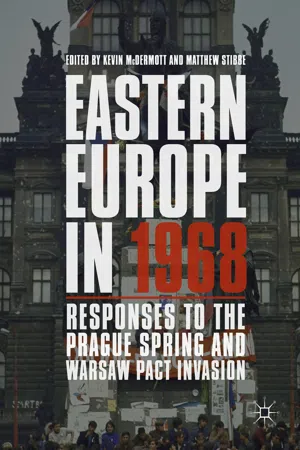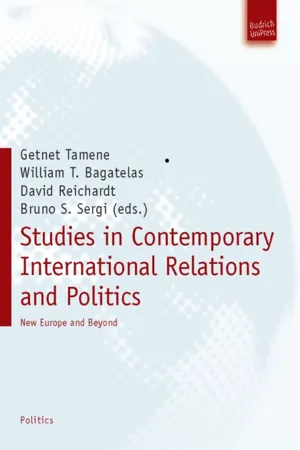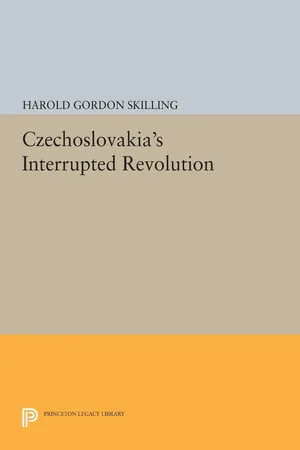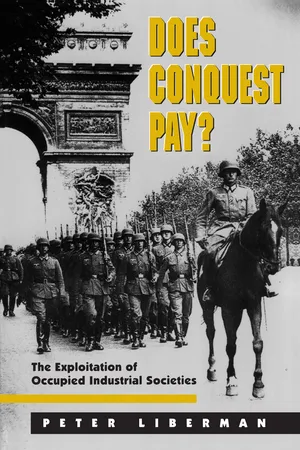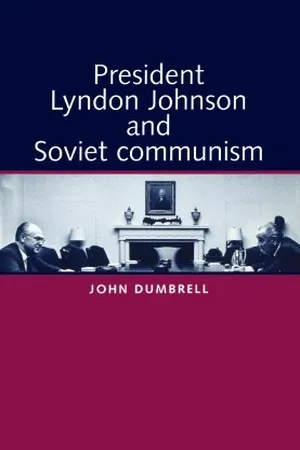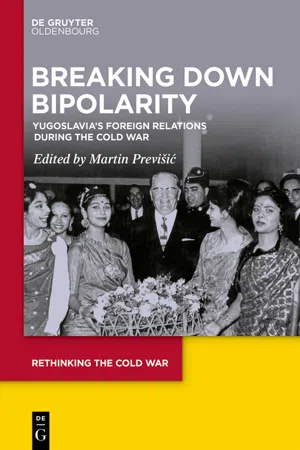History
Soviet invasion of Czechoslovakia
The Soviet invasion of Czechoslovakia refers to the military intervention by the Soviet Union and its Warsaw Pact allies in August 1968. This invasion was a response to the Prague Spring, a period of political liberalization in Czechoslovakia. The invasion aimed to suppress the reforms and maintain Soviet control over the country.
Written by Perlego with AI-assistance
Related key terms
1 of 5
10 Key excerpts on "Soviet invasion of Czechoslovakia"
- eBook - ePub
Eastern Europe in 1968
Responses to the Prague Spring and Warsaw Pact Invasion
- Kevin McDermott, Matthew Stibbe, Kevin McDermott, Matthew Stibbe(Authors)
- 2018(Publication Date)
- Palgrave Macmillan(Publisher)
— conclude that issues of geopolitics and national security were paramount in the decision to suppress the Prague Spring. But other factors must be considered, in addition to the crucial issues of the end of censorship and the demotion of pro-Soviet dignitaries. Ideological ‘deviations’ from classical Marxism-Leninism, the reduction in powers of the secret police and the espousal of genuine legality, the notion of ‘market socialism’ and workers’ councils, limited autonomy in foreign and military affairs, and the exposure of Soviet involvement in the judicial crimes of the 1950s all provoked much consternation in Moscow and other Warsaw Pact capitals. Fed by contentious reports from the KGB and the Soviet embassy in Prague, the Kremlin did not so much fear the collapse of socialism and a return to capitalism in Czechoslovakia, as a thoroughly reformed socialist system based on democratic norms, cultural and civic freedoms and popular participation, a polity that would almost certainly prove highly attractive to the peoples of other East European countries. Hence, regardless of Dubček’s insistent pleas of fidelity to the Soviet Union, by the summer of 1968 the Brezhnevite Politburo had lost political trust in the Czechoslovak reformers and concluded that only military action would ‘normalise’ the situation in its erstwhile ally.It should be emphasised, however, that recourse to armed intervention was very much a final hurdle. Several other forms of pressure had been put on Prague since the early spring of 1968, including hints of economic sanctions, extended Warsaw Pact manoeuvres (code-named ‘Šumava’) on Czechoslovak territory in late June and early July, a propaganda campaign in the Soviet mass media, bilateral and multilateral meetings, ultimately inconclusive, of communist party leaders at Dresden (March), Moscow (May), Warsaw (July), Čierna nad Tisou (July–August) and Bratislava (August), and private communications between Brezhnev and Dubček. As far as the Kremlin was concerned none had worked by August 1968. As for the precise timing of the invasion, the Soviet Politburo wished to pre-empt the convocation of the Fourteenth Extraordinary Congress of the KSČ, scheduled for early September, which would have formally ratified the reformist course undertaken since January and undoubtedly removed many conservative stalwarts from the party’s leading organs. Speculation about divisions in the Soviet elites between ‘doves’ and ‘hawks’ has not been confirmed by recent archival discoveries, but this does not mean that differences did not exist among individuals and relevant bureaucracies.15It is almost universally agreed that three core elements shaped the Kremlin’s decision to invade: military-strategic considerations; the perceived threat to the Soviet model of socialism in Czechoslovakia; and the ‘spill-over’ effect to other East European states. It appears that a pivotal factor was security, both of the USSR and the bloc as a whole. Moscow was fearful that Czechoslovak foreign policy and defence reforms would weaken the unity and military capability of the Warsaw Pact, delay the stationing of Soviet nuclear missiles on Czechoslovak soil and thereby expose the ‘socialist commonwealth’ to American ‘imperialism’ and West German ‘revanchism’. Moreover, the possibility of the Czechoslovak contagion spreading to Poland, Hungary, East Germany and the USSR itself, via Ukraine, raised the spectre of a general loosening of bloc relations. Indeed, for Brezhnev post-war Soviet territorial gains in Eastern Europe were inviolable, ‘even at the cost of risking a new war’.16On the ideological front, which should never be under-estimated, Czechoslovak attempts to re-envisage deeply entrenched Leninist principles such as ‘democratic centralism’ and in particular the party’s ‘leading role’ were viewed as a negation of the very essence of socialism. One expert concluded that ‘perhaps the final Soviet judgment… was that only an invasion could consolidate Soviet hegemony and avert the danger of eventual loss of control of the Communist Party and of its policy in Czechoslovakia, and, ultimately, over the entire area of Eastern Europe’.17 - eBook - PDF
Spying on the World
The Declassified Documents of the Joint Intelligence Committee, 1936-2013
- Richard J. Aldrich, Rory Cormac, Michael S. Goodman(Authors)
- 2014(Publication Date)
- Edinburgh University Press(Publisher)
the Soviet invasion of Czechoslovakia 323 The Czechoslovak Crisis and its Aftermath 49. The Soviet military leaders probably feared, as a result of the Czechoslovak reform programme, that a serious gap in the Warsaw Pact defence structure would develop, either through Czechoslovakia’s defection from the Pact or a decline in the efficiency of her armed forces. In the first place, the Dubcek leadership removed a number of tried pro-Soviet military figures including the Minister of Defence, General Lomsky, two of his depu-ties, the Chief of the General Staff and the Head of the Political Directorate of the Armed Forces, and replaced them by officers whose military abilities and political reliability the Russians may have doubted. Secondly, the Soviet military authorities made specific criticisms of the performance of the Czechoslovak Army in the Warsaw Pact exercise “SUMAVA” in June 1968, and commented on the shortage of tank divisions within the force which the Czechoslovaks proposed to use for the defence of their frontier with West Germany in the event of war. There were reports that in the light of their doubts the Russians made – and the Czechoslovaks rejected – a request to station Soviet troops in Czechoslovakia. If these reports were true, the Czechoslovak refusal may have contributed to a growing Soviet belief that in spite of Czechoslovak assurances of complete loyalty to the Warsaw Pact, in the longer run Czechoslovak loyalty to and interest in the Warsaw Pact could not be taken for granted by the Soviet Union. 50. There has been a steady run-down of Soviet ground and air forces in Czechoslovakia, subsequent to the signing of the Status of Forces agreement on 16th October. The scale of reduction gives credence to Premier Cernik’s statement concerning the agreement, that the Czechoslovak forces are to have responsibility for the defence of the Western frontier of their country returned to them. - Available until 15 Jan |Learn more
Studies in International Relations and Politics
New Europe and Beyond
- William T. Bagatelas, Getnet Tamene, David Reichardt, Bruno Sergi, William T. Bagatelas, Getnet Tamene, David Reichardt, Bruno Sergi(Authors)
- 2010(Publication Date)
- Budrich UniPress(Publisher)
Chapter 5 Withdrawal of Soviet Troops from Central Europe after the Collapse of Communism Milada Polišenská 1 Keywords : Warsaw Pact, Moscow Protocol, Charter 77, Václav Havel, Invasion and Deployment of Soviet Troops in Czechoslovakia At night from 20th to 21st August 1968, more than one half million soldiers from five Warsaw Pact countries invaded Czechoslovakia. Therefore, the attempt of the reform-oriented wing of the CPC (Communist Party of Czechoslovakia) to liberalize and democratize the Communist regime in Czechoslovakia was violently put down. The forced signature of the Prague Spring leaders concerning the “Moscow Protocol” on August 26, represented a basic political victory of intervention that enabled, particularly with the help of the intervention armies, to push through Brezhnev style “normalization”, and liquidate completely the reform process. 2 According to this protocol, the Warsaw Pact armies were supposed to stay in Czechoslovakia only as long as the “threat to the achievements of Socialism in Czechoslovakia and threat to the security of the Socialist system persists.” The Czechoslovak leaders were assured that the intervention armies would leave in three stages and by the spring of 1969 at latest, they would be gone. 3 In order to achieve a quick departure of the troops that were not supposed to stay in the country, the Dubček leadership fulfilled all the Soviet requirements. As a matter of fact, out of one-half million soldiers taking part in the invasion, seventy-five thousand men formed the Soviet military contingent, “temporarily” deployed in Czechoslovakia. As General R. Ducháček stated later, 4 the Czechoslovak government was never informed about the number of Soviet servicemen in Czechoslovakia, as well as the military technology brought in from the Soviet Union into Soviet military zones in Czechoslovakia. - eBook - PDF
- Harold Gordon Skilling(Author)
- 2015(Publication Date)
- Princeton University Press(Publisher)
The stationing of bloc troops in Czechoslovakia, frequently claimed (but without confirmation) to have been urged on the Czechoslovak leader- ship by the Soviet authorities, would not only have served as a means of exerting influence but would perhaps have obviated the need for an in- vasion. 19 Whether the use of force was seriously considered in the middle of July, as later reported by an East Berlin source, cannot be verified. 20 In this context the apparent settlement of the crisis at Cierna and V. Novy, J. Plojhar, J. Pecha, M. Sulek, V. Salgovic, O. Rytir, J. Kudrna, and others (Listy, nos. 1 and 2, 1971). According to Jiri Pelikan, editor of Listy, the "invitation" never really existed. Before the invasion the "signatories" had prom- ised I. I. Udaltsov, of the Soviet embassy, to subscribe to such a statement in order to legalize an eventual invasion, but at the last minute did not do so, owing to fear of popular reaction and to the failure of a new government to be formed. The signatures were therefore added later (Kusin, ed., Czechoslovak Reform, pp. 304-5; Listy, no. 2, 1971, pp. 4-5). 18 The best Western analysis of the motivation and the timing of the invasion continues to be that of Richard Lowenthal, "Sparrow in the Cage," Problems of Communism (Nov.-Dec. 1968), pp. 2-28. Reference at p. 14. Other useful com- mentaries are the following: Wolfe, Soviet Power; Windsor and Roberts, Czecho- slovakia, 1968, esp. pp. 97-105; Kusin, ed., Czechoslovak Reform; Robert R. James, ed., The Czechoslovak Crisis 1968 (London, 1969); Fritz Ermarth, Inter- nationalism, Security and Legitimacy: The Challenge to Soviet Interests in East Europe, 1964-1968 (Rand Corp., Santa Monica, CaI., March 1969); Wolfgang Klaiber, The Crisis in Czechoslovakia in 1968 (Institute for Defense Analyses, Arlington, Va., 1969); Pavel Tigrid, Why Dubcek Fell (London, 1971), pp. 113-36; H. Brahm, Der Kreml und die CSSR, 1968-1969 (Stuttgart, 1970), pp. - eBook - PDF
Revolution and Resistance in Eastern Europe
Challenges to Communist Rule
- Kevin McDermott, Matthew Stibbe(Authors)
- 2006(Publication Date)
- Berg Publishers(Publisher)
The second would have introduced even deeper structural changes, such as relaxation of the Communist Party’s internal discipline to allow greater dialogue; the addition of corporatist chambers to the reinvigorated national legislature to represent key economic sectors; and semi-free elections. The third, lasting from the invasion until its first anniversary, saw the quick evaporation of the elite-driven reforms (except federalisation), but also the emergence of a mass movement of students and workers that was absent from the first Prague Spring. Archives have shed light on all three, but the third, in particular, has benefited from the new sources. 102 • Kieran Williams The Soviet Decision to Invade Without a doubt, the subject on which scholars were most eager for new information was the Soviet decision to send the armies of five Warsaw Pact states into Czechoslovakia on 20 August 1968. 7 The terms of the debate were set in the late 1970s when Ji ř í Valenta combined close reading of official statements, defector and samizdat memoirs, journalists’ rumours and political science frameworks to argue that the Soviet Politburo had divided into two clear factions: one so disturbed by what was happening in Czechoslovakia that they favoured massive intervention; and the other preferring to give Czechoslovak communists more time to restore the rigid order Moscow preferred. On this view, General Secretary Leonid Brezhnev vacillated between the two groups until the hawkish faction prevailed in a Politburo showdown in the middle of August. 8 Although Karen Dawisha dealt this argument a serious blow in her 1984 book, 9 it was very hard to resist the temptation to seek evidence of factional conflict and ordinary politics in the Kremlin before Gorbachev’s rise to power. Now that such matters are less timely, we can afford to accept that crises such as 1968 more united than divided the Soviet command. - eBook - PDF
Does Conquest Pay?
The Exploitation of Occupied Industrial Societies
- Peter Liberman(Author)
- 1998(Publication Date)
- Princeton University Press(Publisher)
57 On August 20, 1968, four hundred thousand Soviet and other Warsaw Pact troops invaded Czechoslovakia forcing the Czech regime to reverse its liberal 134 C H A P T E R 7 reforms, to purge the party and the military, and to replace its maverick leader, Alexander Dubcek, with the more pliant Gustav Husak. Most of the invading forces withdrew by December, leaving fifty thousand to sev-enty-five thousand permanently behind. 58 Soviet forces appeared to pre-pare for an invasion of Poland during the Solidarity crisis of 1980–81, until the Polish regime conducted its own crackdown. Growth and Stagnation, 1945–1985 The Soviet Empire’s record of economic growth is mixed. Until about 1960, Czechoslovakia, Hungary, and Poland matched the growth rates of the more developed West European market economies. East Germany, held back initially by industrial dismantling and other reparations trans-fers, also achieved high growth rates in the 1950s. 59 This was accom-plished through rapid extensive development, the often brutal mobili-zation of human and material resources from small-scale farming into industrial investment and production. In the 1960s the development gap widened, except for East Germany, which was able to keep up. - John Dumbrell(Author)
- 2024(Publication Date)
- Manchester University Press(Publisher)
They have made many bad mistakes. Although the leadership will pull itself together to face the difficulties caused by the Czech invasion, some changes in the leadership will undoubtedly be made. The effect of the Czech invasion is very great inside the Soviet Union. Our policy should be not to slam the door in their faces but to force them to pay a substantial price for their action ... The invasion had occurred, according to Thompson, because Moscow 'con- cluded Dubcek couldn't retain control of the Czech reform elements'. The con- tagion would have spread. At the 4 September meeting, the consensus was that the invasion was not intended as a deliberate rejection of detente. Rusk pointed out that, as Dobrynin emphasised in his contacts with the Administration, the 'Soviet Union is trying to carry on business as usual with us' .11 4 As LBJ put it in an earlier meeting, the post-invasion US-USSR relationship contained 'some plusses and some minuses'. 115 Most senior advisers concurred that the invasion was a vicious, but pre- dictable and even rational, response to a real threat to Soviet power. Admin- istration assessments of the invasion emphasised the remorseless, predictable exercise of Moscow's authority. There was no trace of the optimistic, 'com- munist diversity' language of the 1966-67 bridge-building effort. In technical Crises 173 military terms, according to General Wheeler, the invasion had been 'quick, efficient and effective' . 116 A State Department analysis in late September described the invasion as a 'rational act' which 'should not be seen as the first in a succession of reckless moves by the USSR which could ultimately engage NATO forces'.11 7 The CIA saw the invasion as prompted by 'genuine fear' and undertaken by Moscow with 'some reluctance' . 118 There certainly was a strong whiff of empty ritual in the American response.- eBook - PDF
Poland and the Origins of the Second World War
A Study in Diplomatic History (19381939)
- Marek Kornat, Chris James, Alex Shannon(Authors)
- 2021(Publication Date)
- Peter Lang Group(Publisher)
6, p. 405. 744 I. Lukes, “Stalin and Czechoslovakia in 1938–1939: An Autopsy of a Myth”, The Munich Crisis, 1938. Prelude, p. 17. The Soviet Threat: Reality or Mystification? 185 the time that, once the British-French plan was adopted, Czechoslovakia would no longer consider defending itself. 745 On 23 September 1938, the crisis in Polish-Soviet relations reached its climax. At four o’clock that morning, chargé d’affaires Tadeusz Jankowski (head of the Polish Embassy in Moscow in the absence of Grzybowski, who was on vacation) was summoned to the offices of the Soviet foreign minister. He was received by the Foreign Ministry’s deputy head, Vladimir Potiomkin, who declared that if Poland took military action against Czechoslovakia, the Polish-Soviet non-aggression treaty would be revoked. 746 The Polish diplomat immediately sent the following telegram to Warsaw: At four o’clock this morning, Potiomkin summoned me and, on the recommenda- tion of the government, handed me a note saying: “From various sources, the Soviet government has learned that Polish troops are forming up along the Czech border, that they are preparing for a border crossing and for the occupation of a part of the territory of the Czechoslovak Republic. Although these messages have been widely disseminated and are alarming in nature, the Polish Government has not denied them. The government of the USSR expects such a denial immediately. However, in the event that such a denial does not occur and if Polish troops cross the Czech border and occupy the territory of that country, the Soviet government will consider it necessary to forewarn the Polish Government that under Article 2 of the non-aggression pact of July 1932, the Soviet government would be forced without warning to renounce the said pact in light of the act of aggression against Czechoslovakia.” Potiomkin asked that this démarche be immediately communicated to the foreign minister. - eBook - PDF
Breaking Down Bipolarity
Yugoslavia's Foreign Relations during the Cold War
- Martin Previšić(Author)
- 2021(Publication Date)
- De Gruyter Oldenbourg(Publisher)
Jan Pelikán and Ond ř ej Vojt ě chovský In the Aftermath of the Prague Spring: Yugoslavia and Czechoslovakia 1969 – 1973 Introduction The aim of this chapter¹ is to analyse the crisis in the mutual relations between Yugoslavia and Czechoslovakia caused by the Warsaw Pact intervention from Au-gust 1968 and the following change of Czechoslovak leadership in April 1969. We aim to show that for both Prague and Belgrade the nature of this relationship was an extraordinarily important issue which had implications in their internal politics, as well as for their position on the international stage. The chronological framework for our analysis is the period between April 1969 when Gustáv Husák replaced Alexander Dub č ek on the position of the head of the Communist party of Czechoslovakia (CPC) and October 1973 when Husák visited Josip Broz Tito in Yugoslavia in an official capacity. This meeting on the highest Party level meant that the Yugoslavs had recognised Husák ’ s leadership which put a symbolic end to the crisis. In this period a pattern had been created for the relationship which would be followed by both political elites more or less until the end of the 1980s.² The violent Soviet ending of the Czechoslovak reform period in 1968 initiat-ed a new phase in Yugoslavia ’ s relations with the USSR and its bloc countries. Although Yugoslavia ’ s leader Josip Broz Tito did not approve of many steps and intentions of Alexander Dub č ek ’ s leadership, the Yugoslav representatives perceived the Soviet military intervention in Czechoslovakia as a serious viola-tion of the principle of sovereignty, which also potentially threatened the inter-national position of their country. At this time, Tito ’ s leadership sought a new re-lationship with the Soviet Union and its satellites. A complicated situation developed especially with the new power elite in Czechoslovakia. This study is an outcome of the research funded by the Czech Science Foundation, grant no. - eBook - PDF
Red Tape
Radio and Politics in Czechoslovakia, 1945-1969
- Rosamund Johnston(Author)
- 2024(Publication Date)
- Stanford University Press(Publisher)
After sketching the events of the Prague Spring, this chapter recon- structs the radio listening practices of Czechs and Slovaks in 1968, before ex- amining how state broadcaster Czechoslovak Radio’s output changed over that year. Focusing on the broadcaster’s foreign news desk headed by Milan Weiner, it considers how socialist journalists like him reevaluated their pur- pose and interests, highlighting their cautiousness and trepidation (a point missing from the polemics against Czechoslovak journalism audible at the time around the Eastern Bloc). 2 The chapter finally places the events of the Warsaw Pact invasion of Czechoslovakia in August 1968 into this context, arguing that the voices of the reporters in Weiner’s team came to function as “vocal signatures” during the invasion, evoking these events for listeners (even in the absence of much surviving magnetic tape) for months, and even years, beyond. The events of the Prague Spring were, as Melissa Feinberg writes, “part of the global protest wave in 1968, but . . . had their own dynamic.” 3 They were driven forward, for example, by established political and cultural elites in the Czechoslovak Communist Party in a bid to consolidate socialist rule in Czechoslovakia, rather than by a younger generation of students seeking to undermine existing structures of power. 4 For one of the political and cultural elites who gained in prominence that year, the writer-turned-reformist politician Pavel Kohout, the Prague Spring’s goals were fourfold: federalization of the Czech and Slovak regions of the republic, rehabilitation for the victims of Stalinist justice, “democra- tization, and a new economic model.” 5 Reformists, however, were a diverse bunch, and others added questions of political pluralization or a with- drawal from the Warsaw Pact and declaration of military neutrality to this.
Index pages curate the most relevant extracts from our library of academic textbooks. They’ve been created using an in-house natural language model (NLM), each adding context and meaning to key research topics.
